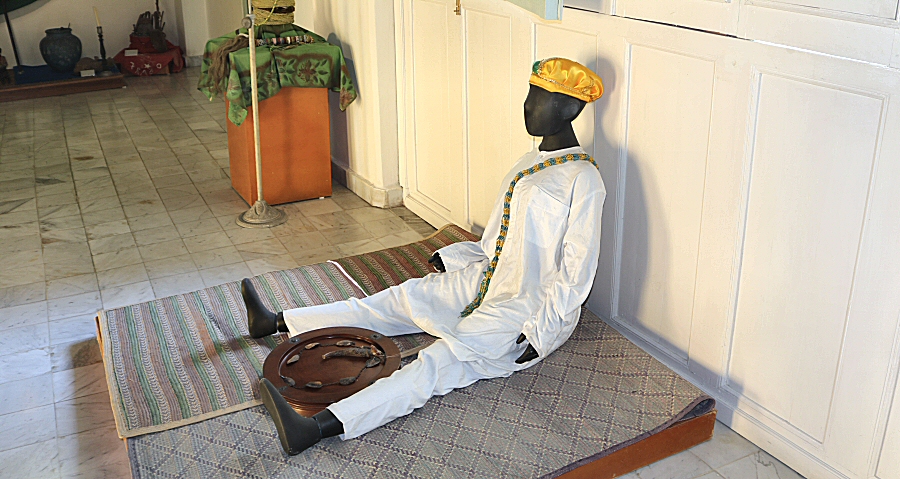

The second floor is dedicated to different cultural
manifestations of Africa. They belong to three ethno-linguistic
groups: the Yoruba, the Bantu and the Calabar, but the
Yoruba objects are in the majority. The artistic objects are
made from different materials, such as vegetable fibers, wood,
clay, ivory, metals and stone.
A rich collection of costumes that
constitute a form of cultural resistance against the European
colonialism, is one of the main features of the museum. A few
baskets that you will see in the rooms, are made of different
vegetable fibers and colorized by the dyes, got form the nature.
To express its gratitude to Fernando Ortiz Fernández, the famous Cuban ethnographer and expert on Afro-Cuban culture, the museum exhibits all the furniture in his study room on the second floor. The term Afro-Cuban was used for the first time by Fernando Ortiz (1881-1969). You will see also the wooden Abakuá masks from his collection, used in different ceremonies.
The second floor contains many samples
of some Afro-Cuban religious expressions, such as Santería, Palo
Monte (a society that has its roots in the cults, practicing in
Kingdom of Congo), and Abakuá (secret Cuban society where only
men were accepted). The guides give some information about the
sculptures of various Santería gods, but it is highly
recommended to read about this religious belief before visiting
the museum. It really takes time to watch all the details on the
sculptures of the Yoruba gods, such as Oshun (represents the
sensuality and the love, owner of the rivers), Eleggua (god of
roads), Oggun (god of metals), Ochosi (god of mountains), Osain
(god of hunting), Obba (goddess of the river Obba in Nigeria),
Obatala (represents the wisdom), Yemaya (goddess of the sea,
considered as universal mother in the Yoruba religion), Oya
(represents the storms) etc. You will see a fortune teller
sitting on the ground. He is the Babalawo, the highest priest of
Yoruba religion. When there were problems or when important
decisions had to be made, he was in charge of interpreting the
Ifaa oracle through his board. Additionally, many wooden masks
are hung on the walls, mostly representing man’s face in varying
expressions.
In the room where a wide variety of
musical instruments from different areas of Africa are
exhibited, the Arará drums are among the striking pieces of the
museum. One of such drums that was carved into an African head,
has been made for a slave tamborero (the musicion that plays the
percussion instrument tambour) by the order of the Arará Sabalú
town council of the Aladá African kingdom (today Benin). The
name Arará was given to the slaves in Cuba that belonged to some
ethnic groups, such as ewe, adjá and fong, captured in the
territory of the ancient kingdom of Dahoney, today Republic of
Benin. Although these African slaves were spread out almost to
the entire island, they could maintain their cult Regla Arará only
in the provinces of Havana and Matanzas (today only in Matanzas).
Another valuable
piece of the drum collection is the Batá drum. A Batá
drum is a double-headed drum, shaped like an hourglass with one
end larger than the other. The percussion instrument is used
primarily in the land of Yoruba, located in Nigeria, as well as
by the worshippers of Santería in Cuba. In Cuba, the batá drums
consist of a set of three that are manufactured in various size.
The largest one, Iyá, is referred to as mother drum, the middle
one, itótele, as father drum, and the smallest one, okónkolo, as
baby drum. The museum has two Batá drums.
Other original African musical
instruments are also exhibited in the same room, such as the
agogó, the yuka, the maracas and the güiro. An agogó,
the oldest samba instrument, is a bell that was used to call the
saints by the Yoruba people. Commonly two bells, each in
different size, are attached by a U-shaped piece of metal, so
that different pitch would be produced depending on which bell
has been hit. The yukas are long drums that are made from
hollowed-out trunks of the avocado tree. The well-known palo
largo is also a yuka with which the first African music was
heard in Cuba. The güiro is a Latin American percussion
instrument consisting of an open-ended, hollow gourd with
parallel notches cut in one side. It is played by rubbing a
stick or tines along the notches to produce a ratchet sound. In
a showcase a musical instrument from Madagascar that was made of
the mandible of a zebu, a rattle from South Africa, maracas from
Mali are exhibited together. Some of the religious musical
instruments were collected by Fernando Ortiz that
constituted the
references for his study on Afro-Cuban culture.
There is also a library, dedicated to
honor his work, for the use of academicians, researchers and
university students that are interested in acquiring knowledge
about the African culture, and a valuable collection of various
pieces from the current 27 African states from which the slaves
were brought to the island.
Currently, the Casa de Africa is the
headquarter of the Scientific Workshop of Afro-American Social
and Cultural Anthropology.